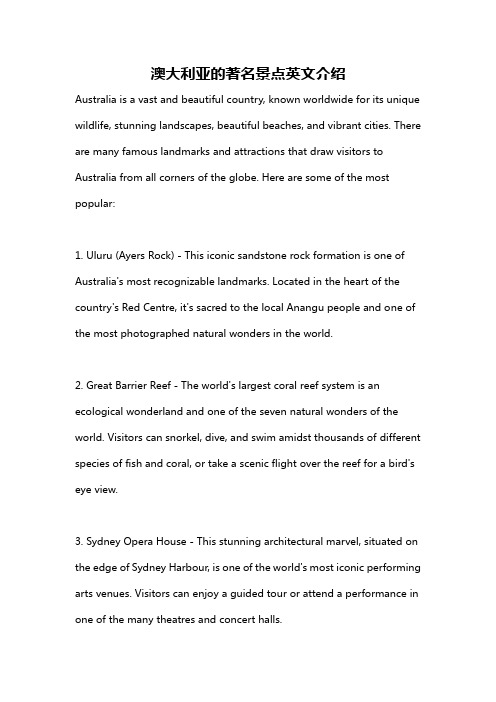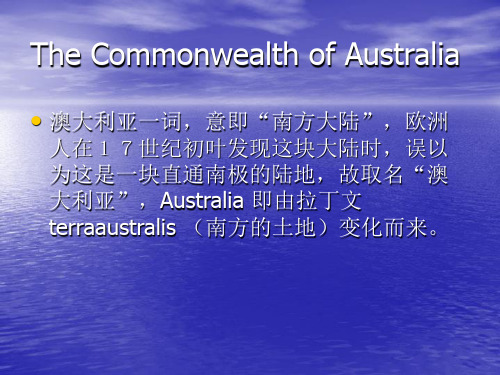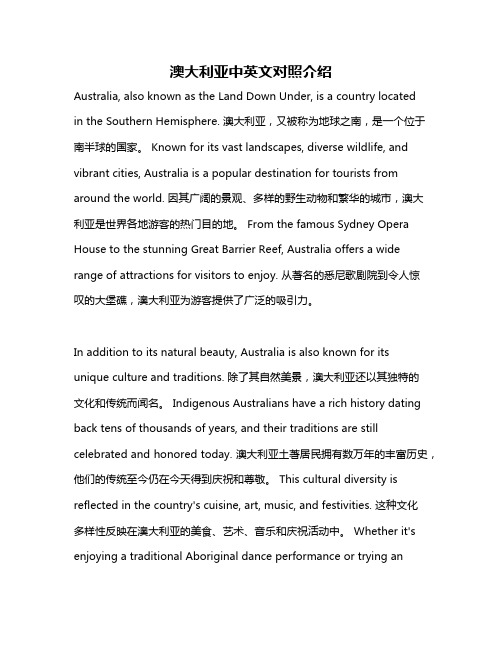关于澳大利亚的英文介绍
Australia(澳大利亚英文介绍)

Festival
Time Over
Nothing Left HaHaHa
AND THEN
THANK YOU
FOR YOUR ATTENTION
Location
Map
Division
· New South Wales · Queensland · South Australia · Tasmania · Vitoria · Western Australia
· Australian Capital Territory · Northern Territory
Koala
Koalas are small bear like creatures who live along the east coast of Australia. Koalas have hard black noses, with sharp claws and a thick furry coat and can grow to a weight of about 10kg. Most of their time is spent asleep in the trees, which is the best place to see a koala.
Echidna
Echidnas live in the dry and hot desertland of Australia. Echidnas catch insects to eat. They grow to about 45cm.
The Echidna is a small creature, which has a furry underside with sharp spines on its back. As a form of protection they quickly bury themselves in the ground, with only their spines sticking out of the ground.
澳大利亚的著名景点英文介绍

澳大利亚的著名景点英文介绍Australia is a vast and beautiful country, known worldwide for its unique wildlife, stunning landscapes, beautiful beaches, and vibrant cities. There are many famous landmarks and attractions that draw visitors to Australia from all corners of the globe. Here are some of the most popular:1. Uluru (Ayers Rock) - This iconic sandstone rock formation is one of Australia's most recognizable landmarks. Located in the heart of the country's Red Centre, it's sacred to the local Anangu people and one of the most photographed natural wonders in the world.2. Great Barrier Reef - The world's largest coral reef system is an ecological wonderland and one of the seven natural wonders of the world. Visitors can snorkel, dive, and swim amidst thousands of different species of fish and coral, or take a scenic flight over the reef for a bird's eye view.3. Sydney Opera House - This stunning architectural marvel, situated on the edge of Sydney Harbour, is one of the world's most iconic performing arts venues. Visitors can enjoy a guided tour or attend a performance in one of the many theatres and concert halls.4. Great Ocean Road -This scenic coastal drive winds along Victoria's south-western coastline, showcasing breathtaking views of rugged cliffs, offshore islands, and iconic landmarks like the Twelve Apostles rock formations.5. Kakadu National Park - This vast wilderness area is famous for its incredible natural beauty, Aboriginal rock art sites, and diverse range of flora and fauna.6. Bondi Beach - This world-famous beach, located just a short distance from Sydney's city center, is a hot spot for surfers, sun-seekers, and beach lovers from all over the world.7. The Whitsunday Islands - This group of 74 islands located in the heart of the Great Barrier Reef boasts some of the world's most beautiful, untouched beaches, and crystal-clear waters perfect for snorkeling and diving.8. The Australian Outback - This rugged and remote region, with its vast deserts and unique landscapes, is home to the famous Uluru, as well as many other unique natural wonders and charming outback towns.9. The Blue Mountains - This stunning mountain range, just a short distance from Sydney, is famous for its dramatic scenery, ancient rock formations, and beautiful bushwalking trails.10. Tasmania - This island state, located off the south coast of Australia, boasts some of the country's most stunning and untouched wilderness areas, historic towns, and beautiful national parks.。
澳大利亚 Australia 英文介绍

西澳的鲨鱼湾(Shark Bay) The Australian Flag
ቤተ መጻሕፍቲ ባይዱ
creature found mainly
It is a very delicious dish in Australia.
in Northern Australia. Currency - notes
Marsupials〔有袋类〕are the most successful group in Australia.
Quoll〔袋鼬)〕
Goanna 〔澳洲巨蜥〕 Echidna 〔针鼹〕
三文鱼 salmon
• People like to eat the raw salmon, and it is really healthy.
牡蛎
Oyster
The animals of Australia
• There are many different species of wildlife in Australia. Marsupials〔有袋类〕are the most successful group in Australia. This group includes kangaroos, wallabies, koalas, Tasmanian wolves〔塔斯马尼亚狼〕, and many others. The platypus〔鸭嘴兽〕 and the echidna 〔针鼹〕are egg-laying mammals. There are also many different species of birds. Some of them are cockatoo(鹦鹉), the flightless emu〔鸸鹋〕, and several types of parrots.
澳大利亚的风土人情英文介绍

Australia: Land of Unique Culture and Enchanting SceneryAustralia, a country that fascinates travelers from around the world, is more than just a land of breathtaking natural beauty. It's a tapestry of rich history, diverse culture, and inviting people.From the moment you step onto Australian soil, you're greeted by the laid-back lifestyle and easygoing attitude of the Aussies. Friendly and approachable, they welcome everyone into their country with open arms. This attitude is perhaps best exemplified by their famous larrikin spirit, a blend of fun-loving irreverence and a stubborn resilience.The culture in Australia is a vibrant mix of Indigenous, European, and Asian influences. The Indigenous population, with their ancient folklore and unique art, have a deep connection to the land that dates back over 50,000 years. European settlers brought their own culture and traditions, which merged with the Indigenous heritage to create a unique Australian identity. Asia has also left its mark on Australian culture, particularly in the areas of food, art, and trade.Australia's landscapes are as diverse as they come. From the red deserts of the Outback to the lush green forests and the Great Barrier Reef r the scenery is nothing short of breathtaking. Add to that the beaches that stretch for miles, the soaring mountains, and the national parks that are home to anabundance of wildlife, and you have a country that is a nature lover's paradise.The cuisine in Australia is just as diverse as its people. From the iconic Australian barbecue to the rich and hearty bush tucker of the Indigenous Australians, there's something for every palate. European settlers have left their mark with dishes like Viennese coffee and Italian pizza, while Asian immigrants have introduced spicy Malaysian satays and fragrant Indian curries.Sports are an integral part of Australian culture. Australians are passionate about their sports teams, whether it's Aussie Rules Football, cricket, or horse racing. And let's not forget about the iconic Olympic Games where Australians have consistently punched above their weight, bringing home medals in a range of sports.So if you're looking for a destination that will captivate your senses with its natural beauty, rich history, and vibrant culture, then look no further than Australia. It's a country that will welcome you with open arms and make you feel right at home.。
英文版澳大利亚介绍 The Commonwealth of Australia

The first station--Sydney
• Sydney is the biggest city which locates at the southeast in Australia. • The best times to visit are of spring and autumn, especially around March to April or
Go l flag of Aus
ⅠThe city of Australia ⅡThe animals of Australia Ⅲ The farms of Australia Ⅳ Indigenous Australians ⅤThe unexpected views of Australia
Australia impression
People usually use these words to discribe Australia,now,let’s have a look!澳大利亚被誉为人间 天堂,英文可分解为 amazing (叹为观止) unexpected(超乎想象) stylish(时尚之巅) tempting(诱人魅力) relaxing(悠然一刻) adventurous(体验极限) liberating(自由自在) inspiring(灵感无限) attractive(梦萦魂牵)。
location
Dreamtime or dreaming 梦幻时代
• 、“梦幻时代”——澳洲土著的精神纽结
在数万年的历史中,土著人创造了丰富的文化,也形成了高度发达 和复杂的宗教信仰、社会制度及法规。虽然土著人从来没有建立过任 何形式的政府和政权,但社会秩序却在他们的宗教信仰的基础上得到 了完好的维持。一代代土著人以口头流传的形式把这些信仰和法规继 承和发展下来。白人到来之后,把这种他们无法理解的土著宗教信仰 和建立于宗教信仰之上的社会体制称为“梦幻”(Dreaming),把他 们到来之前的澳洲土著时空称为“梦幻时代”。“梦幻时代”的土著 人相信人生前死后永远结合在一起,把做梦看作为创造万物之时,并 对此加以口述,代代相传,从而保证土著文化的传承和社会的连续。 翻开土著人的历史篇章,梦幻般的神秘色彩几乎无所不在。尽管以家 庭血缘关系为基础而群居的土著人曾有过成百上千个不同的部落,讲 几百种不同的语言,但是他们对有关祖先的传说和梦幻时代的传说却 都深信不疑。
英文版澳大利亚介绍 The Commonwealth of Australia

Other informations
• 【国庆日】1月26日(1788年) • 【国花】金合欢 • 【国树】桉树 • 【国鸟】琴鸟。它貌似野鸡,常在陆地行走。雄鸟有一条
华美无比的琴形尾,并以尾羽开屏的壮观而闻名。琴鸟的 尾羽与希腊的一种七弦琴极为相似,因故得名。它不仅美 丽动人,还能模仿其它动物的叫声,声音十分宛转动 听。
• 根据澳洲土著人的信仰,祖先神灵曾经借助神秘蟒蛇的躯
体在澳洲大地蜿蜒而行,留下了纵横交错、迷宫一般的足 迹(footmark)。在途中,祖先神灵创造了世间万物,塑 造了今天所有的山川风貌。这就是土著人所信仰的“梦幻 时代”。于是,每一个土著部落都与他们的土地紧密联系 在一起,每一片土地上都设有祭拜祖先的神秘圣地。土著 人的绘画、歌曲和舞蹈,也都反映出他们与土地和祖先的 密切关系。对澳洲土著人来说,起始于世界之初的梦幻时 代的祖先神灵永恒存在,神灵在现代世界仍然活力十足, 并通过土著艺术表现出来。绘画、音乐、舞蹈得以世代相 传,并且永不间断地指导和鼓舞着土著人,即使遭受欧洲 白人的阻隔,也没有失去旺盛的生命力。在今天澳洲各地, 虽然所有的土著部族都经历过不同程度的文化侵扰,他们 的习俗、传统和重要遗址仍旧得以保存,并受到关注、遵 守和尊重。这是因为,梦幻时代创世神灵留传下来的法理、 习俗和行为规范,仍然引领并启示着众多土著后裔的日常 生活。他们靠着这种对梦幻时代的记忆和意识把过去、现 在与将来联系起来。
location
Dreamtime or dreaming 梦幻时代
• 、“梦幻时代”——澳洲土著的精神纽结
在数万年的历史中,土著人创造了丰富的文化,也形成了高度发达 和复杂的宗教信仰、社会制度及法规。虽然土著人从来没有建立过任 何形式的政府和政权,但社会秩序却在他们的宗教信仰的基础上得到 了完好的维持。一代代土著人以口头流传的形式把这些信仰和法规继 承和发展下来。白人到来之后,把这种他们无法理解的土著宗教信仰 和建立于宗教信仰之上的社会体制称为“梦幻”(Dreaming),把他 们到来之前的澳洲土著时空称为“梦幻时代”。“梦幻时代”的土著 人相信人生前死后永远结合在一起,把做梦看作为创造万物之时,并 对此加以口述,代代相传,从而保证土著文化的传承和社会的连续。 翻开土著人的历史篇章,梦幻般的神秘色彩几乎无所不在。尽管以家 庭血缘关系为基础而群居的土著人曾有过成百上千个不同的部落,讲 几百种不同的语言,但是他们对有关祖先的传说和梦幻时代的传说却 都深信不疑。
澳大利亚中英文对照介绍

澳大利亚中英文对照介绍Australia, also known as the Land Down Under, is a country locatedin the Southern Hemisphere. 澳大利亚,又被称为地球之南,是一个位于南半球的国家。
Known for its vast landscapes, diverse wildlife, and vibrant cities, Australia is a popular destination for tourists from around the world. 因其广阔的景观、多样的野生动物和繁华的城市,澳大利亚是世界各地游客的热门目的地。
From the famous Sydney Opera House to the stunning Great Barrier Reef, Australia offers a wide range of attractions for visitors to enjoy. 从著名的悉尼歌剧院到令人惊叹的大堡礁,澳大利亚为游客提供了广泛的吸引力。
In addition to its natural beauty, Australia is also known for its unique culture and traditions. 除了其自然美景,澳大利亚还以其独特的文化和传统而闻名。
Indigenous Australians have a rich history dating back tens of thousands of years, and their traditions are still celebrated and honored today. 澳大利亚土著居民拥有数万年的丰富历史,他们的传统至今仍在今天得到庆祝和尊敬。
This cultural diversity is reflected in the country's cuisine, art, music, and festivities. 这种文化多样性反映在澳大利亚的美食、艺术、音乐和庆祝活动中。
澳大利亚英语介绍

院系:经济管理学院班级:2010市场营销一班学号:2010051538姓名:王鑫Australia is a country in the southern hemisphere(南半球). It lies in most area of Oceanic. Australia is the largest country in the southern part of the Earth, the sixth largest country in the world. land area: 7,692,000 square kilometers, half larger than the whole of Western Europe. Population: 22.5 million (June 2011). The capital of Australia is Canberra. Sydney is the biggest city in the country. The official language in Australia is English.It is large country with very small population. Most of the country is covered with grassland and desert. There are a lot of wild animals living there, like kangaroos(袋鼠)and koalas(考拉). 澳大利亚是一个国家在南半球。
它坐落在最大的海洋上。
澳大利亚是世界上南半球最大的国家,是世界上国土面积第六的国家。
土地面积:7692000平方公里,比整个西欧大一半。
人口:2250万(2011年6月)。
澳大利亚的首都是堪培拉。
悉尼是全国最大的城市。
澳大利亚的官方语言是英语。
它的国土很大但人口数量却很少。
- 1、下载文档前请自行甄别文档内容的完整性,平台不提供额外的编辑、内容补充、找答案等附加服务。
- 2、"仅部分预览"的文档,不可在线预览部分如存在完整性等问题,可反馈申请退款(可完整预览的文档不适用该条件!)。
- 3、如文档侵犯您的权益,请联系客服反馈,我们会尽快为您处理(人工客服工作时间:9:00-18:30)。
关于澳大利亚的英文介绍Australia: An introductionIn land area, Australia is the sixth largest nation after Russia, Canada, China, the United States of America and Brazil. It has, however, a relatively small population.Australia is the only nation to govern an entire continent and its outlying islands. The mainland is the largest island and the smallest, flattest continent on Earth. It lies between 10° and 39°South latitude.The highest point on the mainland, Mount Kosciuszko, is only 2228 metres. Apart from Antarctica, Australia is the driest continent.Australia is the driest inhabited continent on earth. Its interior has one of the lowest rainfalls in the world and about three-quarters of the land is arid or semi-arid. Its fertile areas arewell-watered, however, and these are used very effectively to help feed the world. Sheep and cattle graze in dry country, but care must be taken with the soil. Some grazing land became desert when the long cycles that influence rainfall in Australia turned to drought.The Australian federation consists of six States and two Territories. Most inland borders follow lines of longitude and latitude. The largest State,Western Australia, is about the same size as Western Europe.Natural environmentAustralia has a remarkable diversity of life forms seen nowhere else in the world. Australian plants and animals evolved in isolation from other parts of the world. When the super-continent of Gondwanaland split up about 160 million years ago, Australia joined Antarctica and drifted towards the South Pole, where glaciers formed a barrier between it and other land masses.Over the past 45 million years, Australia has moved away from Antarctica towards the equator and become warmer and more arid. About 35 million years ago, eucalypts began to displace the dense forests of the cool, damp Tertiary era.Today Australian eucalypts account for more than half of all eucalypts found throughout the world. The marsupials native to Australia have a different chromosome structure than mammals in other parts of the world. Typically, they suckle their young in a pouch.Like the eucalypts, marsupials occupied a wide range of ecological niches in Australia. The first kangaroo marsupials seem to have appeared about 15 million years ago. They vary enormously in size and adaptation. A species of tropical kangaroo lives intrees, but most kangaroos are tough, efficient users of dry bush.As the world climate warmed and glaciers melted, oceans gradually rose to their current level and the land bridges to New Guinea and Tasmania were cut. Corals colonised a flooded coastal plain, forming the Great Barrier Reef of Queensland.Ancient plants still grow in the wild. Large'Antarctic' tree ferns are common in damp, shaded gullies on the south sides of ridges. Cycad palms form an understorey to tall, silvery spotted gums (eucalypts) along the south-east coast. Rare relics from earlier geological eras are found in small, special habitats, such as desert canyons. Pressure on native habitats from agriculture and introduced pests like the fox and rabbit have resulted in extinctions of some native species in the past 200 years. Australia now has a strong scientific and legal framework to deal with these issues. Australians care about their unique environment.HistoryMore than 60 000 years before the arrival of European settlers, Aboriginal and Torres Strait Islander peoples inhabited most areas of the Australian European settlement in 1788. However, there were an estimated 300 000 IndigenousAustralians living on the continent.Until recently, Western historians focused on early European contact with the Australian continent during the 16th and 17th centuries.In recent years this approach has been balanced by the recognition that Asian and Oceanic explorers and traders had contact with Indigenous Australian people long before the European expansion into the eastern hemisphere.After the American War of Independence, Britain looked to establish new penal settlements to replace the north Atlantic colonies. The First Fleet of 11 ships with 1500 aboard, half of them convicts, arrived at Botany Bay in January 1788. Sydney grew from that first British penal settlement.Transportation of British convicts to New South Wales ceased in 1840, but continued to Western Australia until 1868. About 160 000 convicts arrived over 80 years. That compares with free settler arrivals as high as 50 000 a year. During the 1850s, settlement was boosted by gold rushes. Scarcity of labour, the vastness of the bush, and new wealth based on farming, mining and trade all contributed to the development of uniquely Australian social institutions and sensibilities. In 1901 the Australian colonies federated to becomethe Commonwealth of Australia. As in Canada, the British monarch remains the monarch of Australia, which is now an independent, democratic nation with a tradition of religious tolerance and free speech. ImmigrationAustralia's culturally diverse society includes its Indigenous peoples and settlers from countries all around the world.Immigration is an important feature of Australian society. Since 1945, over six million people from 200 countries have come to Australia as new settlers. Migrants have made a major contribution to shaping modern Australia. People born overseas make up almost one quarter of the total population.The federal government sets immigration intake numbers on a yearly basis. Australia's immigration policies are non-discriminatory and all applicants to migrate must meet the same selection criteria. Area and population of Australian States and TerritoriesState/TerritoryArea in square kilometresSources: area—Auslig; population—Australian Bureau of Statistics* Estimated resident population as at 30 June 2001. EconomyAustralia has had one of the most outstandingeconomies of the world in recent years. As a high-growth, low-inflation, low interest rate economy, it is more vibrant than ever before. There is an efficient government sector, a flexible labour market and a very competitive business sector.With its abundant physical resources, Australia has enjoyed a high standard of living since the nineteenth century. It has made a comparatively large investment in social infrastructure, including education, training, health and transport.The Australian workforce has seen many improvements over the last decade, leading to the surge in productivity in the 1990s. The complex and centralised award based industrial relations system has given way to a more decentralised one with many employees working under workplace agreements tailored to meet enterprise needs. Further informationAustralian Biodiversity.auNational Library of Australia.au/oz/histsite.htmlDepartment of Immigration and Multicultural and Indigenous Affairs .auThe Australian Government Treasury.auFurther information about other aspects of contemporary Australia。
